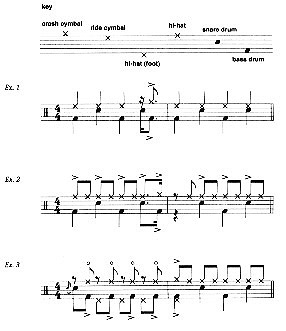Welcome to PaulWertico.com!
Trouble Spots
How Do You Spell Relief?
In the next few articles, we're going to look at some common rhythmic problems that my students and I all have faced. Fortunately, I've managed to analyze their causes and find solutions for them. Let's look at three trouble spots that can create headaches for drummers.
Has this ever happened to you? You're playing an off-beat kick or a series of upbeats, and find yourself either out of time, rushing, or dragging the tempo. Well, don't worry, you're not alone. Each of the following examples contains a slightly different musical element that could cause a drummer to blow the beat.
For instance, some drummers might lose the groove in Ex. 1 while attempting to play the sixteenth-note kick on the e of 4. This is often the result of an instinctive urge to over-anticipate the kick itself. Two problems might happen as a result: The 4 will get rushed, or the drummer will lose sight of where the 1 of the following measure should be placed.
The potential rhythmic hazard in Ex. 2 might spring from incorrect placement of the a of 4, while trying to keep the hi-hat and snare drum backbeat in the pocket. And some drummers might tend to rush or drag the up-beat eighth-notes in Ex. 3.
Okay, these are the problems, but what about the solutions? First of all get a metronome and practice the exercises with it. There's nothing like an absolute timekeeper to clear up any questions about the beat. Then identify and focus on your particular trouble spots whenever you play them. Be aware that they're coming, but stay loose. Don't choke up.

Whether you're rushing the 4 or losing the 1 in Ex. 1, the culprit is the e of 4. So, first practice the two measures without the e of 4. Once you feel locked in with the quarter-note clicks of the metronome, add the e as if it were played off the 4. By not thinking of the off-beat accent as a separate event, or as some really big deal, you'll find it will fit into the groove rather than ruin it.
Ex. 2 can be approached in much the same way. First practice the exercise without the a of 4. Try locking the eighth-notes on the hi-hat inside of the quarter-note clicks by first playing quarter-notes on the hi-hat. Then fit the eighth-notes in between the quarter-notes. When it's grooving play Ex. 2 as written. Also, even though nothing is played on the 1 in the second measure, you should still feel the 1 strongly, and play the a into that invisible 1. This will help keep the groove from stopping.
Finally, Ex. 3 can be played more accurately by paying attention to the quarter-note pulse rather than the up-beats. The eighth-notes on the hi-hat should be closed on the downbeat where written, and by feeling these downbeats as strongly as the pulse, your tempo should remain steady.
If you've observed that the quarter-note pulse is as important as what goes on top of it, you're right. Problems such as the ones we've looked at can be avoided by developing a strong inner pulse. By using a metronome when practicing, you can learn the sound and feel of evenly played quarter-notes, which is the foundation of most groove-oriented music.
Images and Information from Drums & Drumming June/July 1990, page 63